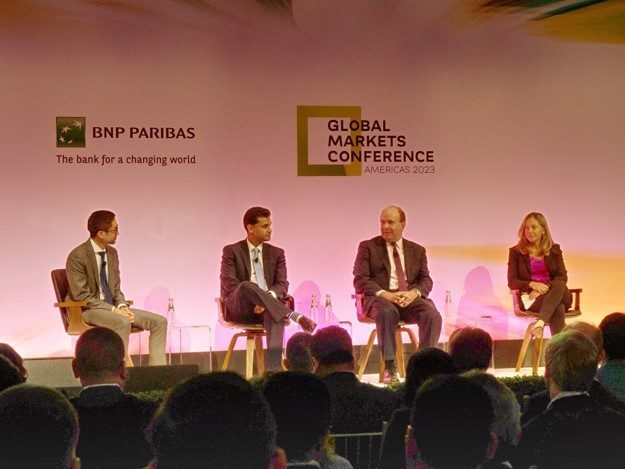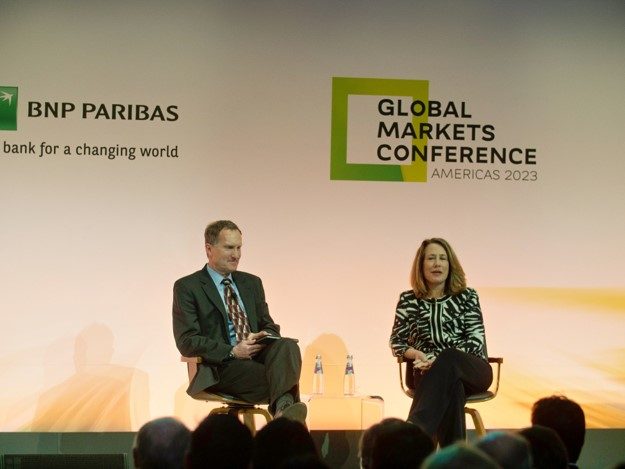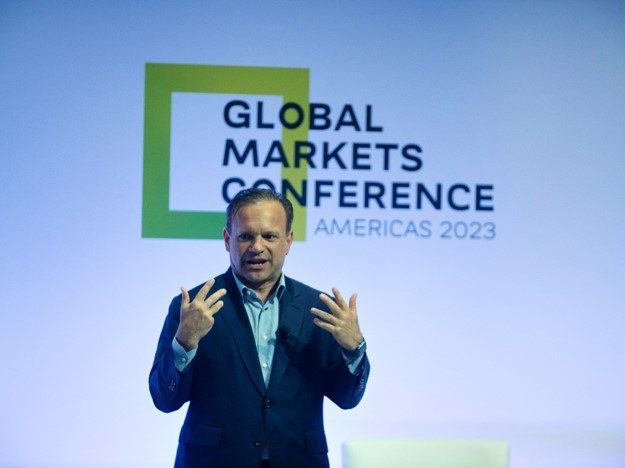At BNP Paribas’ Global Markets Americas Conference on May 23rd in New York City, investors and corporates heard from some of the world’s most influential political, economic and financial figures about the biggest drivers of markets in 2023. Expected catalysts include central bank actions in response to growth and inflation trends, resolution of the U.S. debt ceiling stalemate, geopolitical concerns, structural trends such as de-globalization and AI, challenges faced by certain U.S. regional banks, and the green energy transition.
Over 700 institutional and corporate clients filled the ballroom at the historic Casa Cipriani in downtown Manhattan to hear from industry titans, leading bankers and regulators, renowned economists, and influential journalists, culminating with an exclusive conversation with George W. Bush, the 43rd President of the United States. The theme of the conference was ‘High Velocity: The New Normal’. And although market volatility has temporarily subsided, conference speakers said they expect considerable uncertainties would remain for the rest of 2023 and beyond.
The geopolitical balance of power is shifting
The conference began with a discussion of the stark geopolitical shifts that have occurred since the beginning of the Covid crisis. Following Covid-related supply chain disruptions, China is no longer the default exporter of manufactured goods to the West. In Europe, a parallel rebalancing is happening, following Russia’s invasion of Ukraine, as European countries reduce their dependency on Russian agriculture and natural resources.
Meanwhile, significant global demographic shifts are occurring as some countries including China and Japan experience population declines, while countries in sub-Saharan Africa are growing rapidly. To achieve growth and profit goals, leading companies will need to consider all of these global shifts in their future business and investment decisions.
New technologies will drive U.S. growth
One piece of good news is that the development of new technologies, from artificial intelligence to green hydrogen, is expected to be a significant driver of growth in the U.S. economy, create new jobs, and provide compelling investment opportunities. On ‘The Future of Energy’ panel, speakers discussed the idea that home-grown decarbonization technology, fueled by unprecedented federal subsidies to mitigate climate change in the Inflation Reduction Act, will power the rapid energy transition required to reach net zero, significantly increase domestic production, and produce an accompanying wave of job creation. For certain technologies, such as green hydrogen, panelists said that the U.S. will likely develop a competitive advantage over the rest of the world.
‘Sticky’ inflation will keep interest rates higher for longer
Clients also heard how persistent U.S. inflation will continue to drive monetary policy and impact markets, with the Fed expected to keep interest rates the same or higher than they are today to push inflation down to its 2% target, likely tipping the U.S. into a mild recession. Torsten Slok, Chief Economist at Apollo Global Management, said that the Fed would have to slow the economy significantly in order to achieve its 2% goal. “Maybe there will be some more tightening, or at least higher rates for longer, to get to that point. The question is, might something break in doing that? At least, for now, it’s very clear that the Fed is not going to cut rates any time soon.”
Given uncertainties about how further rate increases will affect interest-rate sensitive sectors of the economy, Esther George, former President and CEO of the Federal Reserve Bank of Kansas City, said that she would be in favor of pausing rate increases in June if she was still on the Federal Open Market Committee, but not stopping altogether. However, she pointed out that the complexity of the financial system is very different than before the last financial crisis and that “monetary policy is not the best way to ensure financial stability.”
Attendees learned that the likely market impacts of interest rates being higher for longer could include a reduction in term bank lending, further credit deterioration, more stresses to the commercial real estate market, and more pressure on regional banks.
However, the discussion with Michael Milken, Chairman of the Milken Institute and Jean-Yves Fillion, Vice Chairman, USA Board of Directors at BNP Paribas, addressed that while people had become accustomed to extremely low rates and cheap funding, it was perfectly possible for companies and investors to prosper in today’s interest rate environment.
Not the 2008 banking crisis
While U.S. regional banks remain under some pressure, every speaker reiterated that recent bank failures bore no similarity to the bank failures of The Great Recession, which were driven by credit risks at some of the largest institutions, not interest rate risks affecting smaller ones.
In the discussion ‘The Banking Sector in Flux’, Sheila Bair, former Chair of the FDIC, said she expected better banking supervision and some reforms as result of recent regional bank failures, particularly concerning the accounting for banks’ hold-to-maturity securities. She didn’t think, however, that there would be much consolidation in the U.S. banking system. “Over the next few years, we may have a few hundred less banks than today, but we’re not going to see the big shake out we had during the Great Financial Crisis,” she said.



Disclaimer
This material is for informational purposes only and is not intended to be a complete and full description of the products of BNP Paribas and its affiliates or the risks they involve. Additional information is available upon request. Neither the information nor any opinion contained in this material constitutes a recommendation, solicitation or offer by BNP Paribas or its affiliates to buy or sell any security, futures contract, options contract, derivative instrument, financial instrument, or service, nor shall it be deemed to provide investment, tax, legal, accounting or other advice. All opinions, information, and estimates in this material constitute BNP Paribas’ or its affiliates’ judgment as of the date of this material. This material is only intended to generate discussions regarding particular instruments and financing and/or investments opportunities and is subject to change, or may be discontinued, without notice. This material should neither be regarded as comprehensive nor sufficient for making financing and/or investment decisions, nor should it be used in place of professional advice. You should consult your own advisors about any products or services described herein in order to evaluate the merits, suitability, and financial, legal, regulatory, accounting and tax issues raised by any investment and should not rely on BNP Paribas or its affiliates for this. Information contained herein is derived from sources generally believed to be reliable, but no warranty is made that such information is accurate, complete or fair and should not be relied on as such. The offer and sale of securities to institutional investors may only be made through the U.S. registered broker dealer and futures commission merchant entity, BNP Paribas Securities Corp.
